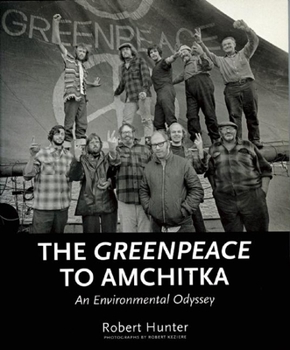The Greenpeace to Amchitka: An Environmental Odyssey
Select Format
Select Condition 
Book Overview
Greenpeace is known around the world for its activism and education surrounding environmental and biodiversity issues. With a presence in more than 40 countries across Europe, the Americas, Asia and... This description may be from another edition of this product.
Format:Paperback
Language:English
ISBN:1551521784
ISBN13:9781551521787
Release Date:April 2005
Publisher:Arsenal Pulp Press
Length:240 Pages
Weight:1.30 lbs.
Dimensions:0.6" x 7.6" x 9.2"
Customer Reviews
3 ratings
An environmental butterfly effect
Published by Thriftbooks.com User , 16 years ago
According to the butterfly effect, the flapping of a butterfly's wings in China can ultimately result in a tornado in North America. That is, small variations in initial conditions of a given system can have large and unpredictible effects. The Greenpeace to Amchitka: An Environmental Odyssey demonstrates how a small act by a determined group of individuals begat the worldwide environmental organisation known as Greenpeace. In 1972, a group of intrepid peaceniks from western Canada, along with a contemplative engineer and a gruff captain, set sail on a dilapidated forty-year old fishing vessel from Vancouver to Amchitka (a small island in the Aleutians), hoping to force the cancellation of nuclear device test by the U.S. government. The Greenpeace To Amitchka is a first-person account by this journey by the late Bob Hunter. Hunter was well known to Torontonians as an environmentalist, newspaper columnist, and television reporter. It is not quite as well known that Hunter was a founding member of Greenpeace and was on the ill-fated voyage of the Phyllis McCormack that fall of 1972. That persevering vessel would be renamed en route as the Greenpeace as it continued the desperate and ultimately futile voyage. The book is written in a late 1960s "gonzo journalism" style reminiscent of writers such as Hunter S. Thompson. As such, the prose comes across as somewhat dated, yet retains a lively and frenetic feel. The tensions between the picaresque participants are captured with unabashed honesty, and Hunter writes with a mixture of humour and pathos. Like Darwin's Voyage of the Beagle, the book provides a vivid description of a remote part of the world that few of us have or ever will see. The book also contains many photographs by Robert Keziere, who perfectly captures the bleak landscapes and stoic countenances of the participants. The voyage was unsuccessful in its initial goal of stopping the nuclear test. Bad weather, frequent delays, harassment by the U.S. Navy, and a rift among the protesters all contributed to the cancellation of the voyage. However, the dejected protesters returned to Vancouver as environmental celebrities, due to the growth of public awareness resulting from media coverage of the voyage. Like the butterfly's wings, this initial futile and seemingly inconsequential event sowed the seed for a trans-national environmental movement... a movement that became Greenpeace.
A Journey That Continues to Inspire
Published by Thriftbooks.com User , 16 years ago
This is a truly allegorical story, an environmental Moby Dick that continues to define the organization (and perhaps a movement) that was born of this journey. Bob Hunter's intense (and sometimes freakishly funny) style of storytelling enables the reader to better understand the very origin of the philosophy, strategies, and values embodied in Greenpeace (and other similar organizations), a quite unique branch of the global environmental movement. The strategical use of media, the direct and confrontational tactics, the embracement of deep ecology, the mixure of tough internal tensions with a true comaraderie are some of the recurring themes of this legendary sail. Although today's environmental movement is way beyond the 60s, the book still proves to be refreshingly direct and honest in a time when the movement is increasingly becoming a "special interest" and constituency/donor-oriented.
Bob Hunter created Greenpeace - read about it here!
Published by Thriftbooks.com User , 19 years ago
Robert Hunter died May 2nd, 2005, shortly after this book was published. I have every book he ever published; every damn one of them is a trip to read, like you're sitting in a bar with this great storyteller and he cannot stop talking - and you don't want him to! Bob was a great storyteller, and this one about the first-ever Greenpeace voyage (indeed, before there even was a Greenpeace!) is as good as anything he ever wrote. Bob was as alive as any man who walked the earth. An incredibly insightful writer who knew how important "getting the story out" was to the cause. It has been said that without Bob Hunter there never would have been a Greenpeace. I agree totally. He wrote with an intensity and with great humor, but never as an outsider. He was totally engulfed in the great causes of early Greenpeace: the whales and seals, the nuclear testing. And the last book he wrote (2030, written in 2002) was all about global warming, also a great read. Bob will be missed! I was lucky to have met and worked with Bob back in the early Greenpeace days. We shared a sixpack of beer and talked about big-picture ecology, life, love - everything we really care about. That was Bob Hunter. With his passing I rededicate my life to what Bob was all about. A great guy, a great writer. I recommend all his books - most of which you'll have to find used by now. I treasure his books on my shelf much like I treasure my collection of Edward Abbey books. Those two guys go great together. Peace Bob! Godspeed!






